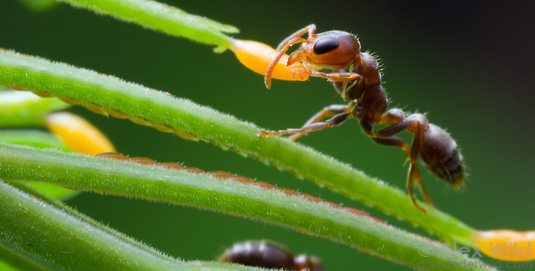The evolutionary history of symbioses between tropical ants and their plant hosts

Ludwig Maximilian University of Munich biologists have studied the evolutionary history of symbioses between tropical ants and their plant hosts. The results show that such relationships are not fixed, and that initial symbionts are likely to be displaced in the long run.
Tropical ants often enter into obligate symbioses with plant hosts, which often prove to be mutually beneficial for both sides. The ants protect their hosts against herbivores, such as caterpillar larvae, and in return they receive cosy nesting-sites and an ample supply of food. How such relationships are initiated and what factors determine their subsequent course are among the major unanswered questions in ecology and evolutionary biology.
"Relatively few studies so far have been devoted specifically the evolution of symbioses involving ant species and their plant hosts," says LMU biologist Professor Susanne Renner. "We have now investigated this issue in detail, focusing on members of the ant subfamily Pseudomyrmecinae, which is found primarily in Central and South America." Renner and her doctoral student Guillaume Chomicki, together with the American myrmecologist Phil Ward – a specialist in ant taxonomy – were able to demonstrate that such symbioses are often subject to dynamic change. Their study appears in the journal Proceedings of the Royal Society B.
The Pseudomyrmecinae encompass 230 species. Of these, 32 are found exclusively in tropical forests in close association with certain tree species. They nest in cavities in twigs or leaf stems, which are pre-fabricated by the host and are referred to as 'domatia'. Moreover, these species together represent the most versatile group of obligate plant-ants known, as they form symbioses with members of several plant genera and families. Among their hosts in Central and South America are acacia species of the genus Vachellia that house various Pseudomyrmex species in characteristic hollow thorns. In this niche, the ants find a rich supply of food, ranging from sugary nectar to food bodies that are rich in both fats and proteins, produced by the plant. In return, the ants defend their hosts against herbivores, parasites, and plant competitors. In other words, these symbioses, in which both partners benefit by cooperating with each other, are mutualistic. Sometimes, however, the relationship is non-reciprocal, and the ants parasitize their hosts, without conferring any advantage on the plant.
Reconstructing the phylogeny of symbioses
In order to elucidate the evolutionary history of the symbioses between these ant species and their hosts, the researchers used DNA sequence data for up to 10 nuclear genes to construct phylogenetic trees for both ants and plants. By then applying the molecular clock method, they were able to determine the temporal sequence of divergence of the lineages leading to the species involved in modern-day symbioses. Comparisons of the trees revealed when each ant species could have formed a symbiotic relationship with its plant hosts. The results clearly demonstrate that such partnerships are not static. The more remote the date of establishment of the initial symbiosis, the greater is the chance that the original symbiotic partner will be evicted. Its niche then becomes available for a different species – for once a plant is forming domatia, there is competition for these living quarters from other plant-nesting ants. Indeed, purely parasitic ant species are always found to be phylogenetically younger than the domatia in which they live (which developed in the context of a true symbiosis). Thus, the parasitic forms are not descended from the original symbionts. They are essentially squatters – generalists that are equipped to make use of any available resource.
"Our study shows that some plant genera initially co-evolved in concert with certain groups of ants that had colonized them. But these were subsequently replaced by other members of the same group, which in turn were displaced by ants belonging to an entirely different group," says Renner. As a result of this type of fluctuation and succession, instances of co-diversification of host and symbiont can only be clearly demonstrated for relatively young lineages. "We were able to detect co-diversification of ants belonging to the Pseudomyrmex ferrugineus group and various members of the acacia genus Vachellia," says Renner. This symbiotic relationship has now lasted for 5 million years, which is not very long in evolutionary terms. Nevertheless, even among the Vachellia, one can find species that have been colonized by phylogenetically younger ant species.
More information: Guillaume Chomicki et al. Macroevolutionary assembly of ant/plant symbioses: ants and their ant-housing plants in the Neotropics , Proceedings of the Royal Society B: Biological Sciences (2015). DOI: 10.1098/rspb.2015.2200
Journal information: Proceedings of the Royal Society B
Provided by Ludwig Maximilian University of Munich




















